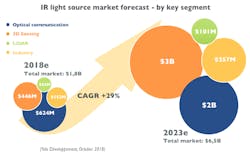IR lighting applications drive growth of IR light sources market
The development of new and smart functionalities in smartphone, medical, and automotive applications, as well as the development of breakthrough devices and functions such as wearables and virtual reality (VR), are pushing the growth of the IR LEDs and laser diodes industry. The IR light-source market is expected to reach US $1.8 billion in 2018 and increase to US $6.5 billion in 2023 with an impressive 29% compound annual growth rate (CAGR) during this period, according to the IR LEDs & Laser Diodes technology & market report by market research and strategy consulting company Yole Développement (Lyon, France).
For the report, which includes analysis of automotive, smartphone, and datacom/telecom applications, Yole collaborated with its partner Knowmade, a technology intelligence and IP strategy consulting outfit, to develop a dedicated section focused on the LED, edge-emitting laser (EEL), and vertical-cavity surface-emitting laser (VCSEL) intellectual property (IP) landscape, including the timeline of IP activity, ranking of patent applicants, a detailed analyze of the historical players and newcomers, and so on.
"More than 40 different applications have been identified as integrating IR SSL sources," says Pierrick Boulay, technology and market analyst at Yole Développement. "Among these, some are expected to make the IR LED and laser diode markets boom in the next five years."
Optical communication, one of the oldest IR light-source applications, is still expected to be one of the major drivers in the coming years. Indeed, the amount of data exchanged on the internet is exploding, and will continue to do so with the emergence of the Internet of Things (IoT), cloud-based services, autonomous cars, and more. Driven by additive manufacturing, industrial applications are also expected to generate high revenue in the coming years. Traditional IR light sources that emit light in all directions and consume large amounts of energy are starting to be replaced by VCSELs that can be individually controlled, resulting in lower energy consumption.
Since Apple's introduction of 3D sensing in its devices, some key Android-based smartphone manufacturers are following a similar strategy and starting to release new products. "3D sensing is not limited to smartphones," says Pars Mukish, business unit manager, solid-state lighting and display at Yole. "It also has potential for automotive lidar, which is necessary for the development of ADAS [advanced driver-assistance systems]. Not surprisingly, many startups in this field have entered the market in order to develop this technology and join the coming revolution."
Finally, 3D sensing is expected to be the killer application for IR light sources. Integration of VCSELs in the iPhone X for facial recognition has generated much interest in 3D sensing: "In 2017 Apple released the iPhone X, with a 3D sensing function based on this technology," says Pierrick Boulay from Yole in the VCSEL report's press release. "It integrates three different VCSEL dies for the proximity sensor and the Face ID module, and made the VCSEL market explode in 2017, propelling overall revenue to about US$330 million."
Initially developed for optical communication applications, LEDs and laser diodes are now integrated into high-value functions. These technologies are part of a new revolution, with each one finding its own path:
- Initially focused on low-end applications (photo interrupters, remote controls, etc.), IR LEDs are now increasingly implemented into smartphones for proximity sensing, automotive for gesture recognition, and VR/AR headsets for eye tracking.
- For EELs, the market has historically been driven by optical communication applications. This is likely to continue, given the always-increasing amount of data exchanged with fiber-optic networks. However, in the midterm, the technology may also find strong growth in new applications, such as lidar. In an interview with Yole, Joerg Strauss, head of the emitter, laser, and sensor segment at Osram Opto Semiconductors, said, "We believe within OSRAM that EEL lasers will continue to be beneficial compared to VCSELs in lidar applications. Primary reason is the required laser power for lidar which is hard to achieve with a reasonable light emission area by VCSEL technology."
- Today, VCSELs might be the fastest-growing technology. Having originally found its sweet spot in short distance data communication, Apple’s 2017 release of the iPhone X has completely changed the business landscape.
Source: http://www.yole.fr/IR_LED_Laser_LightingApplications.aspx#.W79jCmgzaUk
About the Author
John Wallace
Senior Technical Editor (1998-2022)
John Wallace was with Laser Focus World for nearly 25 years, retiring in late June 2022. He obtained a bachelor's degree in mechanical engineering and physics at Rutgers University and a master's in optical engineering at the University of Rochester. Before becoming an editor, John worked as an engineer at RCA, Exxon, Eastman Kodak, and GCA Corporation.

